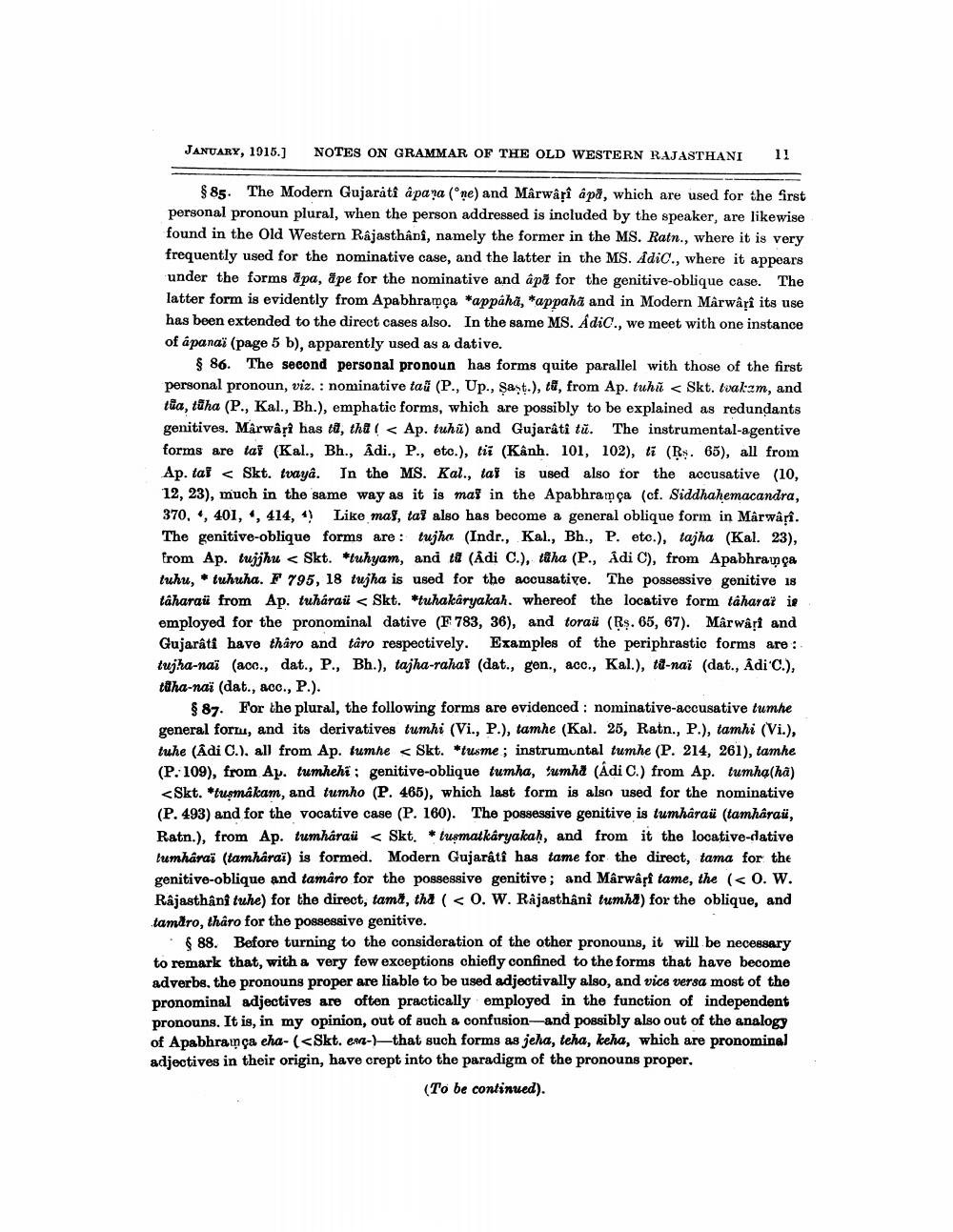________________
JANUARY, 1915.]
NOTES ON GRAMMAR OF THE OLD WESTERN RAJASTHANI
11
$85. The Modern Gujaratî âpana (ne) and Mârwârî âpa, which are used for the first personal pronoun plural, when the person addressed is included by the speaker, are likewise found in the Old Western Râjasthânî, namely the former in the MS. Ratn., where it is very frequently used for the nominative case, and the latter in the MS. AdiC., where it appears under the forms apa, ape for the nominative and apa for the genitive-oblique case. The latter form is evidently from Apabhrança *appáha, *appaha and in Modern Mârwârî its use has been extended to the direct cases also. In the same MS. AdiC., we meet with one instance of apanaï (page 5 b), apparently used as a dative.
§ 86. The second personal pronoun has forms quite parallel with those of the first personal pronoun, viz. : nominative tai (P., Up., Ṣast.), t, from Ap. tuhu Skt. tvakam, and tüa, tüha (P., Kal., Bh.), emphatic forms, which are possibly to be explained as redundants genitives. Mârwârî has tu, thu(< Ap. tuhu) and Gujarâti tu. The instrumental-agentive forms are ta (Kal., Bh., Adi., P., etc.), tii (Kânh. 101, 102), ti (Rs. 65), all from Ap. tal Skt. tvayâ. In the MS. Kal., tai is used also for the accusative (10, 12, 23), much in the same way as it is mat in the Apabhramça (cf. Siddhahemacandra, 370., 401,, 414, 4) Like may, tai also has become a general oblique form in Mârwârî. The genitive-oblique forms are: tujha (Indr., Kal., Bh., P. etc.), tajha (Kal. 23), from Ap. tujjhu < Skt. *tuhyam, and ti (Adi C.), tüha (P., Adi C), from Apabhrança tuhu, tuhuha. F 795, 18 tujha is used for the accusative. The possessive genitive is tâharau from Ap. tuháraü< Skt. *tuhakaryakah. whereof the locative form taharaï is employed for the pronominal dative (F783, 36), and tora (Rs. 65, 67). Marwari and Gujarati have thâro and târo respectively. Examples of the periphrastic forms are: tujha-naï (acc., dat., P., Bh.), tajha-rahat (dat., gen., acc., Kal.), tu-naï (dat., Adi'C.), taha-naï (dat., acc., P.).
§87. For the plural, the following forms are evidenced: nominative-accusative tumhe general form, and its derivatives tumhi (Vi., P.), tamhe (Kal. 25, Ratn., P.), tamhi (Vi.), tuhe (Adi C.). all from Ap. tumhe < Skt. *tusme; instrumental tumhe (P. 214, 261), tamhe (P. 109), from Ap. tumhehi genitive-oblique tumha, tumha (Adi C.) from Ap. tumha(ha) <Skt. *tuşmakam, and tumho (P. 465), which last form is also used for the nominative (P. 493) and for the vocative case (P. 160). The possessive genitive is tumharai (tamhâraü, Ratn.), from Ap. tumharau Skt. *tusmatkâryakaḥ, and from it the locative-dative tumharaï (tamhâraï) is formed. Modern Gujarâtî has tame for the direct, tama for the genitive-oblique and tamaro for the possessive genitive; and Mârwârî tame, the (<0. W. Rajasthânî tuhe) for the direct, tama, tha (<O. W. Rajasthânî tumha) for the oblique, and tamaro, thâro for the possessive genitive.
§ 88. Before turning to the consideration of the other pronouns, it will be necessary to remark that, with a very few exceptions chiefly confined to the forms that have become adverbs, the pronouns proper are liable to be used adjectivally also, and vice versa most of the pronominal adjectives are often practically employed in the function of independent pronouns. It is, in my opinion, out of such a confusion and possibly also out of the analogy of Apabhrança eha- (<Skt. es--that such forms as jeha, teha, keha, which are pronominal adjectives in their origin, have crept into the paradigm of the pronouns proper.
(To be continued).




